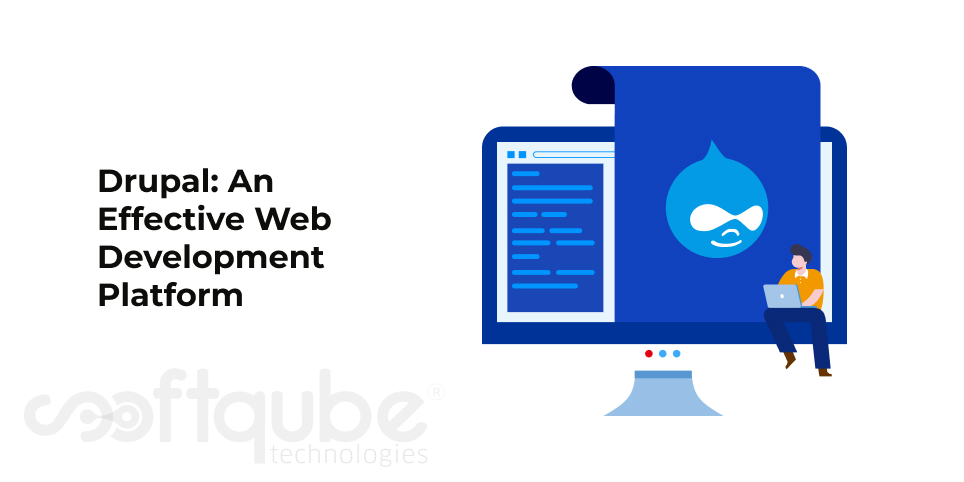Drupal: An Effective Web Development Platform
February 20, 2016

WHAT IS A CONTENT MANAGEMENT SYSTEM?
When the word ‘WEB’ first came into real existence and the way we used to create web pages that time was using Microsoft Front Page or Dream Weaver and this usually required coding each page of the website, that means for a website like Amazon or eBay the designer will end up having millions of pages and the number of files were unusually high. The content management evolutions and concept of dynamic website there and evolving solutions around the same helped to take over here on avoiding such challenges and Drupal happened to be one of the proven solution amongst latest content management solutions used by millions of websites, corporate intranet and media websites today.
Building an Intelligent and Stunning website with Drupal will not just allows you to manage on traditional challenges but also allows you on certain peculiar website needs where one need to understand website traffic for required adaptation there step by step; These needs might be usually one or more from the following –
- Which landing page elements works best?
- Which topics does our audience want more?
- What keywords drive sales?
- Who all are the Top influencers?
- Are ad buys worth it? Which Ones there and things like that
- Authors that create the best content.
- Do people really need a certain feature?
- Whether we need drop downs or flat menus?
- Is the website design is really working for us?
- What marketing and social channels are really driving towards ROI?
- How intuitive our website or blog site is and what makes it stunning and appealing to end users?

DRUPAL 8 FOR BUILDING REAL FAST WEBSITES
At the simplest level, Drupal is piece of software that allows someone to easily manage the content of the website or blog posts through a web browser;
Web development with Drupal means working around Designing and building sites on Drupal, custom module development, Site Maintenance, Ubercart customization, Audit and Reporting, query optimization and server tuning for Drupal Sites, Drupal Migration Services, Automatic Backup and Restore Services, Site Administration and Server Management Services.
In addition, it can accommodate the following aspects for enhanced performance:-
- Backend optimization
- Boost, Memcache
- Setting up Drupal and using Apache Solr along side
- A/B Testing tools

In this post, we shall elaborate on following common aspects required towards building fast and effective websites with Drupal 8 i.e.
- What Drupal 8 does better and why and how it can be a good fit and where?
- Basic Drupal Concepts
- Aspects of a web application and managing Layouts
- Managing Content in Drupal
- Content Presentation
- Roles and Permissions
- Workflows around Content
- Rules & Business Logic
- Other Drupal Features
When we usually need to build a web application form, couple of things, we always need to do take care of like ease to learn system & technology, ability to leverage on existing systems, so that we just don’t end up reinventing the wheel, ability to quickly customize, build and scale in order to support future growth and things like that.
Drupal is a content management system build on PHP,MySQL, HTML, JS and CSS which allows collection, presentation and management of structured information for building websites or dynamic web applications. Drupal provides API’s to build and extend the application with extensible, modular, pluggable and scalable modules (thousands of them), without even need of writing a single line of code. Drupal is in fact more than a content management system and if we name it a development framework to build applications at rapid pace would have been more appropriate.
Drupal is usually a good fit for out of the box fully functional stable and secure website building needs on top of robust CMS and that too out of the box with ability to build apps using inbuilt workflows, permission sets and rules. It supports out of the box CRUD system for complex data collection, presentation and management needs with control over layouts without requiring any coding effort. All together with out of the box support for future extensibility via strong API’s.
Basic Drupal Concepts include Templates, Entity & Node, Content Types, Modules – core & Contrib, Themes, Blocks & Menus, Roles & Permissions, Administration, Hooks & Callbacks and Form API.
When we need to build a basic web application from a fresh, we usually encounter with need to structure the layout and the information, presentation of information, provision roles and permissions, implement business logic required along with optional workflow provisioning related to collected information.
Managing layout in Drupal means structure of layout, working with themes, regions, block system, customizing HTML, working with Panels, Panes, Landing Pages and Contexts.
Managing Content/Data means working with Entity, Node, Content Types, Fields, Form Edits, Taxonomy, listings and Web-forms.
For presentation of content, we need to abstract data with views in Drupal, working with Views display, pages, blocks, feeds, panes, view theming and CSV/XML exports.
Drupal allows access control via roles and permissions at interface and code levels for users and mapping the same via roles and permissions.
Application which need to be provisioned for workflows around content need to handle views & dashboards, roles & permissions in views, mode queues, flags, bulk operations on views, editing/viewing permissions in corresponding modules including workflow module.
Rules and Business Logic implementation requires working with Events & Triggers, Context & Data, Actions, eMail Sending features, Redirecting users, update content, setting values, creating custom actions and exposing custom events.
On Ecommerce & Payments Drupal provides commerce functionality like Ubercart, PayPal integration, integration with Cyber source and other banking gateway integration provisioning modules.
Drupal Commons is an OOTB Social Site supported by Acquia which is actually a social networking system available out of the box with optional integrations with other prevailing social networking systems alongside ability to extend using modules or via custom code.
Drupal provides few other cool features on multisite and domain handling, Aegir for deployments & PaaS support, third party integration, import and export of data, XMLRPC, REST, JSON support, backend for mobile apps with support on mobile theming.
WHEN AND WHEN NOT TO USE DRUPAL?
Though lots of people believe Drupal can do everything, we should focus on where exactly Drupal should be used and where not at all.
Drupal was originally intended to be a content management system. Every website has content and how you wish to manage it, makes a difference, and also, the overall flow of the software. The Drupal ideally should be termed a workflow management solution for managing content by multiple users for website(s).
As far as static sites are concerned, it can be built in very short time, few minutes in some cases but that is not where Drupal is to be leveraged. A static site generator solution like WINTERSMITH or JACKO should be used.
Take Away:
Moreover, today, when the world is moving towards API first methodology; the mobile and web app needs responsive template leveraged by API to customize quickly in almost no time. Drupal is adapting Symphony PHP framework there to become a good fit by building version 8 and onwards .a CMS backed by API’s. Symphony allows for easy API development.
Hope this blog post is useful to you. Let us know about your feedback for the same. For more such details, stay connected with Softqube Technologies; a well known provider of web development services India.
Share on







